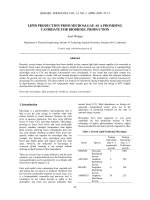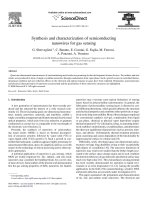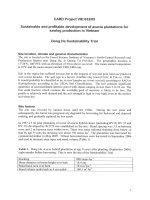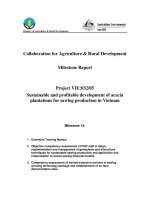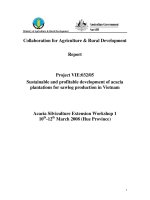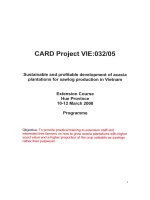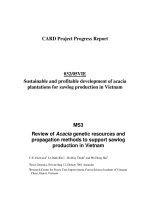characterization of residual oils for biodiesel production
Bạn đang xem bản rút gọn của tài liệu. Xem và tải ngay bản đầy đủ của tài liệu tại đây (359.66 KB, 7 trang )
Electronic Journal of Biotechnology 17 (2014) 39–45
Contents lists available at ScienceDirect
Electronic Journal of Biotechnology
Characterization of residual oils for biodiesel production
Edmilson Antonio Canesin a, Cláudio Celestino de Oliveira b, Makoto Matsushita b,
Lucia Felicidade Dias c, Mayka Reghiany Pedrão c, Nilson Evelazio de Souza c,⁎
a
b
c
Departamento Acadêmico de Qmica e Biologia, Universidade Tecnológica Federal do Paraná, Campus Apucarana, Rua Marcílio Dias, 635, CEP 86812–460, Apucarana, PR, Brazil
Departamento de Química, Centro de Ciências Exatas, Universidade Estadual de Maringá, Avenida Colombo, 5790, CEP 87100–900, Maringá, PR, Brazil
Programa de Pús-graduaỗóo em Tecnologia de Alimentos, Universidade Tecnolúgica Federal do Paraná, Rua dos Pioneiros, 3131, CEP 86036–370, Londrina, PR, Brazil
a r t i c l e
i n f o
a b s t r a c t
Background: Residual oils were characterized according to their physicochemical properties, i.e. acidity, iodine
value, peroxide value and saponification number, to evaluate the degradation level and viability for biodiesel
production.
Results: The methyl esters of fatty acids (FAME) from samples of residual bovine, chicken and soybean oils were
quantified by using four transesterification methods, using acidic and basic catalysis and, gas chromatography
with flame ionization detector (GC–FID). Methods that used acidic catalysis at a lower temperature were the
most efficient. Methyl biodiesel samples were synthesized by basic catalysis (KOH) for all quantified oils and
the physicochemical properties of the biofuel were evaluated, i.e. viscosity, flash and fire points, density, water
content, iodine and acidity numbers.
Conclusions: The obtained results suggesting that it is possible to take advantage of these residues for biodiesel
production as the obtained products were approved according to the rules established by the National
Association of Petroleum (ANP); the bovine samples were the exception regarding moisture and acidity.
Article history:
Received 22 May 2013
Accepted 22 November 2013
Available online 3 January 2014
Keywords:
Biodiesel properties
Gas chromatography
Infrared
Transesterification methods
© 2014 Pontificia Universidad Católica de Valparso. Production and hosting by Elsevier B.V. All rights reserved.
1. Introduction
The increase in the global population, the search for comfort,
day-to-day activities, industrial growth and the increase in purchasing
power and personal consumption are factors that contribute to
increased energy consumption and have increased environmental
problems as well as waste generation. Heightened concern for the
environment and increasing emissions of greenhouse and acid
rain causing gases, associated with price increases and oil shortages,
have stimulated the search for renewable fuels that can reduce the
consumption or even completely replace petroleum-derived fuels.
Currently, petroleum-derived fuels are broadly used in industry,
agriculture and transport; in other words, petroleum is an essential
⁎ Corresponding author.
E-mail address: (N.E. de Souza).
Peer review under responsibility of Pontificia Universidad Católica de Valparso.
fuel source for humans [1]. The constant reduction in global reserves
and the possible exhaustion of them, added to the higher and higher
costs of extraction and pollution emissions, mostly with sulfur, makes
the search for alternative renewable fuel seven more attractive [2].
In the last three decades, a search has been made for methods or
products which can replace petroleum as an energy source, including
residual waste of industries [3,4]. Thus, biodiesel originating from
vegetable oils represents a good alternative to replace part of petroleum
use; however, the large scale consumption of comestible oil for energy
generation may lead to a crisis regarding food supplies and induce
economic disequilibrium.
The price of comestible oil, which represents about 70% of biodiesel
production costs, could increase as a consequence of higher demand,
which is a considerable obstacle for industrial biodiesel development
[5]. To circumvent this problem, improvements in the transesterification
process using acidic, basic and enzymatic catalysis, or even combinations
of these, may increase the reaction efficiency and make it faster and more
economically viable [3,6].
Biodiesel is an alternative diesel fuel composed of alkyl monoesters
of fatty acids derived from vegetable or animal oils and fats,
produced mainly by an acidic or basic catalytic route involving the
transesterification of oil, animal or vegetable fat with short chain alcohols
[7]. This fuel has become an interesting alternative for diesel motors, as it
has similar properties to mineral diesel oil, and can even replace it
0717-3458/$ – see front matter © 2014 Pontificia Universidad Católica de Valparso. Production and hosting by Elsevier B.V. All rights reserved.
/>
40
E.A. Canesin et al. / Electronic Journal of Biotechnology 17 (2014) 39–45
without modifications to current motors. Biodiesel is a biodegradable
product, is non-toxic, can be produced from many renewable energy
sources like vegetable oils or animal fat with low commercial value and
is less harmful to the environment than diesel oil, mainly because sulfur
is not used in the matrix or production process [8,9].
In this way, the present work aimed to evaluate the quality of residual
oils of bovine, chicken and soy origin, to quantify the predominant fatty
acids, to perform basic methylic transesterification to obtain biodiesel
and to evaluate some properties of the resulting biodiesel.
2. Materials and methods
2.1. Experimental sampling
The residual oils and fats of bovine and chicken origin were collected
in two places which sell roasted meats in the city of Apucarana, PR. Both
use independent gas stoves for chicken and meat, the latter mixed with
small quantities of pork in some cases. The residues were collected in
polyethylene containers and taken to the laboratory where, after
being heated to about 40°C, they were strained (mesh 60) and filtered
through a 100% polypropylene commercial filter. The samples were
subsequently stored in opaque polyethylene containers at room
temperature and protected from light. Samples of residual soy oil from
frying of domestic origin were also used, which went through the
filtration and storage process already described.
2.2. Physicochemical characterization of residual oils and fats
2.2.1. Peroxide index by iodometric titration
About 5.0 g ± 0.1 mg of oil was solubilized in 30.0 mL of a mixture
of acetic acid/chloroform (3:2 v/v) in a sealed Erlenmeyer, then iodide
was added in excess to the sample, which reacted with the peroxides
to form I2 according to Eq. (1):
ỵ
2 ROOH ỵ 2H ỵ 2I I2 ỵ 2 ROH ỵ H2 O
ẵEquation1
Although the water solubility of I2 is low, with an excess of iodide,
the formation of triiodide (I3) occurs, which is very soluble. The formed
iodine was titrated with sodium thiosulfate (0.01 mol L-1) in the
presence of an amide solution (0.7% m/v) as indicator.
2
I2 ỵ 2 S2 O3 2 I ỵ S4 O6
2
ẵEquation2
The samples were protected from light, covered and kept at 20 °C
during the procedure, thereby minimizing iodide loss and consequent
titration errors [10,11].
2.2.2. Acid number (AN)
The oil samples were titrated in triplicate using 0.5 g ± 0.1 mg in a
125 mL Erlenmeyer, then 10.0 mL of a 1:1 mixture (v/v) of ethanol and
ethyl ether was added, using phenolphthalein drops (0.1% in ethanol) as
the indicator. The titration was performed with an aqueous solution of
KOH 0.01 mol L-1, properly standardized with a solution of potassium
biphthalate [12,13].
ỵ
RCOOH ỵ KOHRCOO K þ H2 O
½Equation3
2.2.3. Saponification index
In the triplicate analysis, 1.0 g ± 0.1 mg of oil or fat was used, in
100.0 mL flat-bottomed and ground-joint flasks. Then, 20.0 mL of an
alcoholic solution of KOH (50 g L-1 in ethanol) was added and heated
at reflux for 90 min. After cooling, the excess KOH was titrated with
1.0 mol L- 1 HCl solution, which was previously standardized using
phenolphthalein as indicator. A blank sample was also prepared
containing only the alcoholic KOH solution [12].
2.2.4. Iodine number (InI)
In the triplicate determination, 0.25 g ± 0.1 mg of oil or fat in was
added to a 250 mL Erlenmeyer and 10.0 mL of hexane and 20.0 mL of
Wijs reagent were added. It was left covered and agitated in an oven at
20°C in the dark for 30 min. Then, 10.0 mL of KI solution at 15% (m/v)
and 100 mL of freshly boiled and cold distilled water were added and
the solution was titrated with 0.10 mol L-1 sodium thiosulfate solution,
using amide solution (0.7% m/v) close to the final point as indicator [3,12].
2.2.5. Infrared analysis
Analyses were performed using an FTIR BOMEM-MB-100
(Hartmann & Braun, Québec, Canada) device, with a NaCl window and
scanning from 4000 to 500 cm-1, with the purpose of confirming band
vibration characteristics, such as trans double bonds (strong bands
between 980–960 cm- 1), free carboxyl groups (in two well-defined
bands at 1650 and 1400 cm - 1 ) and peroxide groups (in two
well-defined bands at 1125 and 1100 cm- 1) [14,15].
2.3. Preparation of methyl esters for quantification
Four methods of esterification were used as described in the literature
for the identification and quantification of fatty acids present in the
samples. Two were basic catalysis methods and two were acidic
catalysis methods, with the objective of evaluating the best approach for
each type of oil.
All methods used 15 × 150 mm Pyrex glass tubes with a screw cap
and silicone seal ring, using a previously calibrated analytical balance
with an accuracy of 0.1 mg, containing the internal standard methyl
tricosanoate (Sigma-Aldrich). The internal standard solution was
prepared at a concentration of 1.0 mg mL- 1 in heptane added to the
transesterification container. The solvent was evaporated under a
nitrogen flow and was stored in a freezer at -15°C.
2.3.1. Method described by Bannon et al. (BA)
To about 150 mg of oil, 5.0 mL of a sodium methoxide solution
(NaOMe, 0.25 mol- 1 L) in methanol/ethyl ether 1:1 (v/v) was
added and agitated for 2 min. Next, 3.0 mL of heptane and 15.0 mL of
saturated sodium chloride solution were added. The mixture was
again vigorously agitated for 15 s and, after phase separation; the
upper phase, containing the methyl esters of fatty acids, was collected.
Samples were analyzed by gas chromatography (CG) [16].
2.3.2. Method described by ISO 5509 (ISO)
Approximately 1.0 g of oil was mixed with 10.0 mL of heptane and
stirred until solubilization. Then, 0.50 mL of 2.0 mol L- 1 NaOH in
methanol was added and agitated for 20 s. After phase separation, the
supernatant was collected for analysis by GC [17].
2.3.3. Method described by Hartman and Lago (HL)
About 250 mg of oil was added to a tube of esterification, then
5.0 mL of 0.50 mol L-1 NaOH solution in methanol was added and the
mixture was warmed for 5 min. Next, 15.0 mL of esterification reagent
(prepared from a mixture of 2.0 g of ammonium chloride, 60.0 mL of
methanol and 3.0 mL of concentrated sulfuric acid, warmed for about
15 min) were added and the mixture was warmed for more 3 min.
After cooling, the mixture was transferred to a separation funnel along
with 25.0 mL of petroleum ether and 50.0 mL of deionized water and,
after agitation and separation of the phases, the aqueous phase was
discarded. Then, 25.0 mL of deionized water was added to the organic
phase, stirred and, after phase separation, the aqueous phase was
discarded and the procedure was repeated. The organic phase was
collected, the solvent was evaporated in a rotary evaporator and the
residual solvent was removed under nitrogen flow. The methyl esters
were dissolved in heptane for subsequent injection into the GC [18].
E.A. Canesin et al. / Electronic Journal of Biotechnology 17 (2014) 39–45
2.3.4. Method described by Jham et al. (JA)
About 40 mg of oil was transferred into a tube, then 1.0 mL of KOH
solution 0.50 mol L-1 was added in methanol and warmed in a bath at
100 °C for 5 min. Then 400 mL of HCl in aqueous methanol (4:1 v/v)
was added and the mixture was warmed in a bath at 100 °C for
15 min. The tube was cooled and then 2.0 mL of deionized water and
3.0 mL of petroleum ether were added and stirred. After collection of
the supernatant, 3.0 mL of petroleum ether was added to the tube,
agitated and added to the fraction collected earlier. The solvent was
evaporated in a rotary evaporator and the esters were redissolved in
500 mL of chloroform for subsequent injection into the GC [19].
2.4. Chromatographic analysis of the methyl esters
The fatty acid methyl esters (FAME) were separated in a CP-3380 gas
chromatograph (Varian, USA) equipped with a flame ionization detector
and a fused silica capillary column (CP-7420, 100 m × 0.25 mm i.d., and
0.25 μm film thickness, 100% cyanopropyl, Varian, USA). Gas flow rates
were 1.4 mL m-1 for the carrier gas (H2), 30 mL m-1 for the auxiliary
gas (N2) and 30 and 300 mL m-1 for H2 and synthetic air for the flame,
respectively.
The sample was divided (split) 1/80 and the injector and detector
temperatures were 235 °C. The column temperature was 170 °C for
6 m, then increased to 230 °C at a rate of 3 °C m-1 and, it was kept at
this temperature for 2 min. The total analysis time was 28 min. The analytical signals and peak areas were processed by Star software (Varian).
The sample injected volume was of 1 μL (n = 3) and the
identification of fatty acids was based on the comparison of
retention times with those obtained to the methyl esters standard
mixtures containing the geometric isomers of linoleic acid (Sigma)
and alpha-linolenic acid. In the calculus it was taken into account the
values of the equivalent length of the chain (ECL) according to the method
described by Visentainer and Franco [20].
2.5. Methyl esters quantification
Quantification was performed in relation to the internal standard,
methyl tricosoanate (23:0 Me). To determine the amount of AG
identified in samples of oil and fat (in milligrams/gram), Eq. (4) was
used [20]
MX ¼ ðAX x MP x F CT ị=AP x M A x F CEA ị
ẵEquation4
where:
MX
MP
MA
AX
AP
FCT
FCEA
mass of the fatty acid X in mg g -1 of oil or fat.
mass of the internal standard in milligrams.
sample weight in grams.
area of fatty acid X.
area of the internal standard.
theoretical correction factor.
conversion factor for fatty acid methyl ester.
The results obtained in the quantification of methyl esters were
subjected to analysis of variance (ANOVA) at the 5% probability by the
Tukey test, using statistical software (Assistat 7.6 — free version).
2.6. Methylic synthesis of biodiesel
Transesterification was performed with 250.00 ± 0.50 g of each
oil sample through basic catalysis using potassium hydroxide dissolved
in anhydrous methanol (1.25% m/v). The reaction occurred in a 6:1 M
ratio of methanol under reflux, under 800 rpm agitation at the
temperature of 55 ± 2°C for 20 min [21].
After transesterification, the mixtures were allowed to stand for
10 min before decanting into a pear-type separating funnel. The
41
glycerin phase with excess methanol was separated and the ester
phase was washed, first with 200 mL of a 2% aqueous solution of acetic
acid at 80°C and, then twice more with 200 mL of distilled water at 80°C
with agitation in the funnel. After complete decantation of the aqueous
phase, after the last wash for an hour, biodiesel was filtered through
anhydrous sodium sulfate and stored in amber glass bottles at room
temperature.
2.7. Physicochemical characterization of residual oil biodiesel
In order to be sold, biodiesel from any source must comply with a
series of established properties by ANP (National Agency of Petroleum
and Natural Gas). In this study, the following parameters were
evaluated:
2.7.1. Kinematic viscosity (ν)
It was used a QUIMIS microprocessor viscometer (model Q860M26)
coupled to a system of ultra thermo stated circulation (SOLAB)
for temperature stabilization of the samples at 20.0 ± 0.1°C and
40.0 ± 0.1°C. The equipment had been previously calibrated using
standard glycerin P.A. (Vetec, 99.9% purity).
2.7.2. Flash point and fire point
A QUIMIS flashpoint device (model Q292) with a Cleveland open
cup type was used, which meets the American Society for Testing and
Materials (ASTM D92) regulations for all petroleum derivatives with a
flash point above 79°C.
2.7.3. Density (15°C)
A set of densimeters appropriate for oil derivatives was used
(Mercurio INMETRO, certification number 14438426) in conjunction
with an ultra thermo stated circulation system at 15.0 ± 0.1°C (SOLAB
mark), which kept the sample at the analysis temperature (15 °C)
using a circulating water cooling system.
2.7.4. Acid number (AN)
The samples were analyzed using the same method described above
for residual oils, in quadruplicate.
2.7.5. Iodine number (InI)
The determination of iodine number was performed in triplicate,
based on the procedure described above and using the same method
for residual oils.
2.7.6. Water content
Karl-Fischer titration was used to determine the water content in
biodiesel using semi-automatic equipment (QUIMIS, modelQ349). The
method is based on potentiometric titration with detection by a
platinum electrode. The classic Karl-Fischer reaction is based on the
Bunsen reaction used for the determination of sulfur dioxide in aqueous
solution [22].
ỵ
SO2 ỵ I2 ỵ 2 H2 O4H ỵ SO4
2
ỵ2I
ẵEquation5
The Karl-Fischer reagent is composed of iodine, sulfur dioxide and
methanol, without pyridine (Vetec). The stoichiometry of the reaction
regarding water and iodine was 1:1. The method was based on the
ASTM D4377 regulation, using chloroform/methanol (3:1 v/v) as the
solvent. Initially, the Karl-Fischer reagent was calibrated with about
20 μL of water, using a micro-syringe previously calibrated using a
balance with accuracy of 0.1 mg. Then samples of biodiesel were titrated
in triplicate using about 0.2000 ± 0.0001 g, with the insertion of the
sample directly into the reactor cup to avoid moisture contamination.
42
E.A. Canesin et al. / Electronic Journal of Biotechnology 17 (2014) 39–45
3. Results and discussion
3.1. Characterization of residual oils
The characterization of some physicochemical aspects of residual oils
before biodiesel synthesis was helpful to evaluate the quality of the raw
material, mainly regarding the possible degradation mechanisms as raw
material degradation may cause a decrease in the yield of esters.
The determination of the presence of hydroperoxides in oils helps
in assessing the degradation level of this oil, which can occur
mainly due to exposure to high temperatures. The iodometric titration
method was used for peroxide index determination because the
method is fast, inexpensive and reasonably precise when peroxide
values are higher than 1 meq O2 kg-1. The oxidation level of refined
soybean oil is considered low when the peroxide index (IP) is between
1.0 and 5.0 meq O2 kg-1 of oil; moderate when IP is between 5.0
and 10.0 meq O2 kg-1of oil and high if the IP is greater than 10 meq
O2 kg- 1 of oil. Considering this criterion, the tested samples showed
elevated IP (Table 1), data that were confirmed by IR spectra (Fig. 1).
The acid index is a qualitative value of oils and fats, as well as
the peroxide index and reflects the amount of free fatty acids present
in the samples. Free fatty acids have different origins, such as high
temperatures, when residual frying oil is used, or oxidation that can
occur in the presence of peroxides or light [23]. The analyzed raw
material presented elevated acidity (Table 1), when compared to fresh
soybean oil (0.20 mg KOH g-1), and this factor makes the production
of biodiesel difficult as free fatty acids can impair the transesterification
reactions as during basic catalysis they can be saponified [24].
The saponification index (IS), which consists of complete hydrolysis
of triacylglycerols in alkaline solutions, leads to the formation of salts of
fatty acids, and can be used for a quick assessment of the potential
formation of esters by determining the percentage of esters using
Eq. (6):
Ester percent ẳ 100 x ISIAị=IS:
6ị
According to Table 1, compared with fresh soybean oil, which
presented an ester percentage of 99.89%, the other oils intended for
biodiesel production presented a lower ester percent, but this level
was still considered sufficient to obtain excellent yields in biodiesel
production as the ANP recommends a minimum of 96.5% esters and
all samples met this level [7].
A reduction in the iodine index occurs over time or with exposure to
high temperatures, so samples of oils and fats containing unsaturated
fatty acids can be evaluated to assess the degradation level of the oil
[25,26]. In soybean oil samples, the average reduction of 11% in the
iodine index of used soybean oil (121.34%) compared to that of fresh
soybean oil (135.08%), as shown in Table 1, was probably caused by
elevated temperature exposure and also by a high IP [10]. The iodine
number of oils extracted from cattle and chickens showed slightly
lower values than soybean oil samples. Such a reduction can also be
associated with the presence of a lower concentration of polyunsaturated
fatty acids, as shown in Table 2.
Fig. 1. Infrared spectrum of chicken residual oil — Sample 4.
Regarding the attempted transesterification methods, taking as a
basis the higher yield in methyl esters obtained (FAME total in mg g-1
in Table 2), the ISO and BA methods were the most efficient, in general,
for residual oils. Since they are transesterification processes that occur at
room temperature, they can minimize the formation of soaps directly
with free fatty acids, depending on the relatively high acidity of the
tested samples and leads to an energy economy in industrial process.
Regarding the HL and JA methods, which employ heating at 100°C
with a basic catalyst as the first step, there was a lower yield since the
free fatty acids had saponified. This practice must be carefully observed
when producing biodiesel since basic catalysis at high temperatures will
probably contribute to a decline in the yield of the obtained biodiesel [3].
The samples derived from cattle and chicken stand out in at least
two important aspects, according to Table 2. The first aspect is a
low concentration of polyunsaturated fatty acids, with an average
under 280 mg g-1 in bovine samples and under 205 mg g-1 in chicken
samples, considering all the quantification methods used. These values
can be compared to fresh soybean oil, which has a well-known
composition with more than half of its mass of this type of fatty acids.
The lower concentration of polyunsaturated acids also justifies the
lower InI of animal oils (Table 1).
The second aspect is a higher concentration of saturated fatty acids,
with an average above 250 mg g- 1 for the bovine oils and over
270 mg g- 1 for the chicken oils, also using fresh soybean oil as a
comparison. These characteristics may significantly influence the
properties of biodiesel produced from bovine or chicken oil, as saturated
chains may cause an increase in viscosity, clogging point and cloud
point. However, the lower concentration of polyunsaturated acids may
have a positive effect, due to an improvement in oxidative stability
during the storage of biofuel.
In the quantification of fatty acids in animal oils, there was also a
greater variety of shorter chains fatty acids such as C14:1(n-7), C15:0,
C16:1(n-9), C16:1(n-7), C17:0 and C17:1(n-7) in bovine samples,
which is not common in traditional soybean oil (Table 3). The shorter
chains could contribute to a reduction in viscosity, a chronic problem
with biodiesel, but the methyl ester provides a significant increase
Table 1
Physicochemical parameters of residual oils from cattle (1, 2 and 3), residual oils from chicken (4 and 5), residual soybean oil (6) and fresh soybean oil (7), used to obtain biodiesel.
Samples
AN
(mg KOH g-1)
IS
(mg KOH g-1)
% Ester
IP
(meq O2 kg-1)
InI
(%)
1-Residual bovin
2-Residual bovin
3-Residual bovin
4-Residual chicken
5-Residual chicken
6-Residual soybean
7-Fresh soybean
2.25
3.41
2.29
2.28
1.80
2.15
0.20
180.1
171.3
187.4
182.5
177.5
184.4
196.0
98.75
98.01
98.78
98.75
98.98
98.83
99.89
47.52
89.35
59.80
84.30
16.63
13.77
3.130
109.02
108.53
112.59
107.12
112.79
121.34
135.08
±
±
±
±
±
±
±
0.05
0.11
0.08
0.03
0.02
0.05
0.02
±
±
±
±
±
±
±
4.4
3.8
2.3
5.4
3.5
4.7
1.8
AN = Acidity number; IS = Saponification index; IP = Peroxide index; InI = Iodine number.
±
±
±
±
±
±
±
2.58
3.45
1.15
4.50
1.84
1.52
0.52
±
±
±
±
±
±
±
1.23
3.59
1.16
5.17
2.38
6.45
4.69
E.A. Canesin et al. / Electronic Journal of Biotechnology 17 (2014) 39–45
43
Table 2
Concentration of methyl esters of fatty acids (mg g-1) obtained in residual bovine oils (samples 1, 2 and 3), residual chicken oils (samples 4 and 5), residual soybean oil (sample 6) and
fresh soybean oil (sample 7), employing different esterification methods.
Samples
Transesterification methods
(BA)
256 ± 2a
383 ± 2c
274 ± 3a
3.45 ± 0.57c
913 ± 6a
247 ± 4ab
398 ± 5c
292 ± 2ac
3.13 ± 0.27d
937 ± 9a
278 ± 3b
388 ± 4a
289 ± 2b
2.96 ± 0.08
955 ± 7a
287 ± 1a
471 ± 8A
188 ± 7
5.48 ± 0.26a
946 ± 9a
284 ± 8b
433 ± 8abc
224 ± 5abc
4.28 ± 0.02ab
941 ± 20
171 ± 5a
308 ± 6a
468 ± 3a
3.65 ± 0.15abc
947 ± 13b
138 ± 4
246 ± 2
522 ± 5
11.7 ± 4.8
906 ± 4
Σ SFA
Σ MUFA
Σ PUFA
ΣtransFAME
⁎Total FAME
Σ SFA
Σ MUFA
Σ PUFA
ΣtransFAME
⁎Total FAME
Σ SFA
Σ MUFA
Σ PUFA
ΣtransFAME
⁎Total FAME
Σ SFA
Σ MUFA
Σ PUFA
ΣtransFAME
⁎Total FAME
Σ SFA
Σ MUFA
Σ PUFA
ΣtransFAME
⁎Total FAME
Σ SFA
Σ MUFA
Σ PUFA
ΣtransFAME
⁎Total FAME
Σ SFA
Σ MUFA
Σ PUFA
ΣtransFAME
⁎Total FAME
1
2
3
4
5
6
7
(ISO)
260 ± 5a
399 ± 5a
288 ± 1b
1.42 ± 0.05ab
947 ± 14b
247 ± 3ac
387 ± 3b
302 ± 6a
0.55 ± 0.10c
936 ± 13a
260 ± 4a
384 ± 5ab
279 ± 3a
2.73 ± 0.15
923 ± 15ab
267 ± 4b
457 ± 4ab
188 ± 2
2.75 ± 0.59b
912 ± 9b
263 ± 4a
423 ± 4a
212 ± 4ad
5.29 ± 0.69ac
898 ± 16
169 ± 5a
293 ± 2b
444 ± 9a
3.50 ± 0.41ad
906 ± 6c
(HL)
255 ± 4a
390 ± 2ab
250 ± 4c
2.19 ± 0.22a
895 ± 9c
235 ± 4d
367 ± 4a
277 ± 6b
1.41 ± 0.20a
879 ± 11b
232 ± 3c
353 ± 2c
245 ± 2c
2.28 ± 0.08
830 ± 4c
287 ± 1a
471 ± 8a
188 ± 7
5.48 ± 0.26a
946 ± 8c
260 ± 6a
445 ± 6bd
223 ± 3bde
3.96 ± 0.56bc
928 ± 5
151 ± 5b
262 ± 3c
421 ± 6c
4.20 ± 0.16bde
834 ± 8a
(JA)
246 ± 1b
391 ± 2b
260 ± 2c
1.29 ± 0.14b
897 ± 4c
241 ± 3bcd
374 ± 5a
282 ± 1bc
1.52 ± 0.08a
897 ± 6c
252 ± 2a
376 ± 6b
277 ± 4a
2.57 ± 1.11
905 ± 12b
267 ± 5b
451 ± 4b
182 ± 3
–
900 ± 11b
251 ± 3a
448 ± 6cd
235 ± 6CE
1.26 ± 0.97d
934 ± 1
152 ± 4b
267 ± 5c
425 ± 6c
4.42 ± 0.52ce
844 ± 14a
⁎Represents ΣSFA + ΣMUFA + ΣPUFA. SFA = Saturated Fatty Acids; MUFA = Monounsaturated Fatty Acids and PUFA = Polyunsaturated Fatty Acids. Results expressed as
average ± standard deviation. Different letters in the same row indicate significant differences (P b 0. 05) by Tukey test between applied methods. BA = Method described by
Bannon et al. [16]; ISO = Method described by ISO 5509 [17]; HL = Method described by Hartman and Lago [18]; JA = Method described by Jham et al. [19].
Table 3
Mean concentrations of methyl esters and fatty acids (mg g-1) obtained in bovine residual
oil using different methods of esterification.
FAME
(BA)
(IS0)
(HL)
(JA)
C14:0
C14:1(n-7)
C15:0
C16:0
C16:1(n-9)
C16:1(n-7)
C17:0
C17:1(n-7)
C18:0
C18:1(n-9)
C18:1(n-7)
C18:2 t
C18:2(n-6)
C18:3(n-6)
C18:3(n-3)
C18:3 t
C20:0
C20:1(n-9) t
C20:1(n-9)
C20:2(n-6)
C22:0
C22:2(n-6)
C24:0
9.25 ± 0.43
3.48 ± 0.08b
1.91 ± 0.20d
175 ± 2a
6.22 ± 0.41d
28.2 ± 1.0
2.34 ± 0.31a
2.42 ± 0.18b
53.2 ± 0.6a
317 ± 2a
13.0 ± 0.2a
1.98 ± 0.17b
239 ± 2a
0.738 ± 0.206b
19.6 ± 0.5a
1.48 ± 0.42a
–
–
3.10 ± 0.25a
2.82 ± 0.21a
2.52 ± 0.44a
–
–
8.63 ± 0.21
1.14 ± 0.22a
1.13 ± 0.14ab
186 ± 3b
3.29 ± 0.21ab
28.0 ± 1.7
4.13 ± 0.35bc
1.64 ± 0.37a
54.3 ± 1.5ab
353 ± 3b
8.52 ± 0.51b
0.310 ± 0.080a
266 ± 1b
1.40 ± 0.21a
18.1 ± 0.7ab
1.11 ± 0.11ab
0.77 ± 0.12a
–
3.73 ± 0.19b
1.88 ± 0.19b
2.44 ± 0.16ab
–
1.07 ± 0.15a
8.12 ± 1.06
1.46 ± 0.15a
0.97 ± 0.01ac
189 ± 2c
3.09 ± 0.43ac
28.3 ± 1.6
3.73 ± 0.08abd
1.82 ± 0.12a
47.6 ± 1.1c
347 ± 2c
6.38 ± 0.32c
0.326 ± 0.033a
226 ± 2c
1.18 ± 0.07a
18.9 ± 1.2a
0.805 ± 0.050bc
0.885 ± 0.040b
1.06 ± 0.13
4.37 ± 0.19c
2.36 ± 0.11c
2.78 ± 0.10ab
0.27 ± 0.04
0.911 ± 0.09ab
8.63 ± 0.69
2.15 ± 0.33c
1.03 ± 0.22bc
183 ± 1d
3.53 ± 0.24bc
29.8 ± 1.0
3.99 ± 1.10cd
–
57.1 ± 1.1b
341 ± 1d
11.6 ± 1.1a
–
248 ± 3d
–
20.8 ± 0.9ab
1.30 ± 0.15ac
–
–
2.75 ± 0.18a
–
1.53 ± 0.32c
–
0.66 ± 0.15b
Results expressed as average ± standard deviation of nine replicates. Different letters in
the same row indicate significant differences (P b 0.05) by the Tukey test between
applied methods. FAME = Fatty Acid methyl Ester; BA = Method described by Bannon
et al. [16]; ISO = Method described by ISO 5509 [17]; HL = Method described by
Hartman and Lago [18]; JA = Method described by Jham et al. [19].
from stearic acid (C16:0), a saturated chain at a concentration almost
twice the traditional soybean oil average (98 mg g- 1) [27]. This may
cause increased viscosity in methyl biodiesel derived from bovine
sources helping to maintain the viscosity at the recommended values.
3.2. Physical properties of animal biodiesel
High viscosity significantly reduces the flow of fuel; the ANP
recommends a limit of 6.0 mm2 s-1. Since unsaturated chains contribute
to a reduction in viscosity and an increase in the unsaturation number,
they will also significantly reduce this parameter [28]. The biodiesel
samples synthesized by the methyl route from residual oils were within
the limits of the ANP (Table 4) and were very satisfactory when
compared, for example, to biodiesel obtained from some oilseeds,
such as castor bean biodiesel, which may have an average viscosity
of 12–15 mm 2 s - 1 , or Moringa oleifera Lam oil with a viscosity of
13.56 mm2 s- 1 [29].
The flash point represents the temperature at which the fuel becomes
a potentially flammable mixture when exposed to a spark or flame, and
is a very significant property in engine performance. The presence of
alcohols, such as methanol, resulted from the transesterification process
directly affects the flash point. According to the ASTM guidelines,
biodiesel must have a minimum value of 131°C for this property. All
animal samples that were synthesized fit within this limit (Table 4).
The density of methyl esters in more common vegetable oils such as
sunflower, canola, soybean, corn and cotton are very close, assuming
values between 0.883 and 0.885 g cm-3; whereas density of petroleum
diesel normally ranges between 0.837 and 0.842 g cm-3. This means
44
E.A. Canesin et al. / Electronic Journal of Biotechnology 17 (2014) 39–45
Table 4
Physicochemical properties of biodiesel obtained in residual bovine oils (samples 1, 2 and 3), residual chicken oils (samples 4 and 5), residual soybean oil (sample 6) and fresh soybean oil
(sample 7), using basic methyl catalysis.
Properties
Methyl biodiesel
ν 20°C (mm s )⁎
ν 40°C (mm2s-1)⁎
Flash point (°C)⁎
Fire point (°C)⁎
Density (g cm-3)⁎⁎
2 -1
Water content (ppm)⁎
InI (gI2 100 g-1)⁎
Acid number (mg KOH g-1)⁎⁎⁎
1
2
3
4
5
6
7
6.90 ± 0.04
4.12 ± 0. 09
157 ± 2
176 ± 3
0.872
555 ± 15
79.7 ± 0.5
0.75 ± 0.10
6.38 ± 0.08
4.07 ± 0.12
167 ± 1
186 ± 1
0.878
591 ± 18
81.8 ± 0.8
0.72 ± 0.12
7.37 ± 0.07
4.26 ± 0.11
166 ± 3
182 ± 1
0.882
527 ± 34
78.6 ± 1
0.86 ± 0.08
6.26 ± 0.12
3.43 ± 0.18
159 ± 2
184 ± 4
0.877
480 ± 14
72.2 ± 0.9
0.71 ± 0.09
7.41 ± 0.03
3.48 ± 0.09
162 ± 3
182 ± 1
0.874
406 ± 8
71.7 ± 0.8
0.52 ± 0.05
5.46 ± 0.09
3.48 ± 0.11
142 ± 3
189 ± 4
0.880
498 ± 12
93.3 ± 1
0.34 ± 0.08
4.77 ± 0.05
3.01 ± 0.10
138 ± 1
177 ± 2
0.871
440 ± 12
118 ± 2
0.35 ± 0.10
⁎ Results expressed as average ± standard deviation of three replicates.
⁎⁎ Results expressed as duplicate average.
⁎⁎⁎ Results expressed as average ± standard deviation of four replicates.
that the use of methyl esters blended with petroleum diesel leads to an
increased density of the final product, which is good for operating the
engine in general, because higher densities mean a higher mass of
injected fuel, more carbon, more heat and, consequently, more power.
However, according to Alptekin and Canakci [13], this increase is only
significant in mixtures using more than 20% methyl esters in petroleum
diesel.
Water content is an important factor in quality control as its
presence can promote microbial growth, lead to the corrosion of
tanks, participates in emulsion formation and mainly stimulates the
hydrolysis of esters. For these reasons, the limit of water has been
established at 0.05% according to European and American guidelines
and Karl-Fischer titration is used for determining the water content in
samples [30]. The iodine number should ideally to stay below 120 g of
I2 to 100 g of sample, as under this value fuels are less susceptible to
oxidation and polymerization processes, allowing storage with fewer
issues in terms of conservation [25].
As shown in Table 4, the treatment process of biodiesel with sodium
sulfate was sufficient to reduce the water content within the established
limits set by the ANP for almost all samples; only the bovine samples
(1, 2 and 3) showed water content above the allowed limit. The iodine
numbers are within the limits established by EN14111, with a maximum
of 120 g of I2 for 100 g-1 of biofuel, because the presence of unsaturation
decreases oxidative stability and facilitates polymer formation, increasing
the viscosity during storage. This result is quite compatible with the
chemical composition of methyl esters, since 80% of all animal samples
have an InI fewer less 80.
One of the problems with biodiesel produced from residual animal
oils, where 80% of samples did not meet the limit determined by
ASTM D664, i.e. a maximum limit of 0.5 mg KOH g-1 (Table 4), is the
high value of acidity. This was shown by values up to 0.75 mg KOH g-1
in sample 3. Only sample 5, was within the limit of average error,
which was not seen in the soybean oil samples, either residual or fresh
oil. These characteristics can be corrected by blending the biodiesel
with petroleum diesel (B5) or by ion exchange resin treatment.
4. Concluding remarks
Transesterification methods using elevated temperature and basic
catalysts greatly decrease the yield of methyl esters in oil samples with
considerable acidity. The residual bovine and chicken oils showed a
composition of methyl esters different from traditional soybean oil,
with a higher concentration of saturated and monounsaturated fatty
acids and a similar reduction in polyunsaturated fatty acids. Biodiesel
from residual animal oils is able to meet the parameters determined by
the ANP. Although slightly higher in viscosity compared to fresh soybean
oil due to the higher concentration of FAMEs, animal oil biodiesel is still
within the limits both in terms of ASTM guidelines. The flash point,
combustion point and density of biodiesel samples from residual oil
were higher than for traditional petroleum diesel, which may improve
the quality of the marketed mixture, currently known as B5, which
contains 5% biodiesel in petroleum diesel. The iodine number presented
very satisfactory values, indicating stability during storage and a lower
tendency to form polymers. The water content and acid number, which
were a little above the established limit, can be compensated for in the
B5 mixture or can be subjected to treatment to reduce these values.
Suggested methods include passage through a column packed with ion
exchange resin for the reduction of acidity, as well as further filtration
through anhydrous sodium sulfate to retain more moisture.
Acknowledgements
The authors thank the UEM Graduate Program in Chemistry, UTFPR
for the laboratory space and CNPq and Fundaỗóo Araucária for the
financial support.
References
[1] Shahid EM, Jamal Y. A review of biodiesel as vehicular fuel. Renew Sust Energ Rev
2008;12:2484–94. />[2] Demirbas A. Biodiesel production via non-catalytic SCF method and
biodiesel fuel characteristics. Energy Convers Manag 2006;47:2271–82.
/>[3] Jeong GT, Yang HS, Park DH. Optimization of transesterification of animal fat
ester using response surface methodology. Bioresour Technol 2009;100:25–30.
/>[4] Bernal M, Tinoco LK, Torres L, Romero DM, Montoya D. Evaluating Colombian
Clostridium spp. strains' hydrogen production using glycerol as substrate. Electron
J Biotechnol 2013;16. />[5] Zhang Y, Dubé MA, McLean DD, Kates M. Biodiesel production from waste cooking
oil: 2. Economic assessment and sensitivity analysis. Bioresour Technol
2003;90:229–40. />[6] Zullaikah S, Lai CC, Vali SR, Ju YH. A two-step acid-catalyzed process for the
production of biodiesel from rice brain oil. Bioresour Technol 2005;96:1889–96.
/>[7] Agência Nacional do Petróleo, Gás Natural e Biocombustíveis (ANP). [cited January
2013]. Available from Internet />[8] Koc
AB.
Ultrasonic
monitoring
of
glycerol
settling
during
transesterification of soybean oil. Bioresour Technol 2009;100:19–24.
/>[9] Ibeto CN, Ofoefule AU, Ezeugwu HC. Fuel quality assessment of biodiesel produced
from groundnut oil (Arachis hypogea) and its blend with petroleum diesel. Am J
Food Technol 2011;6:798–803. />[10] Gómez MFD, Lozano OEL, Regueiferio MG, Mancho RG, Barragán MSA,
Force EM. Estudio comparativo de La ozonización de aceites de girasol
modificados genéticamente y sin modificar. Quim Nova 2009;32:2467–72.
/>[11] Hage DS, Carr JD. Química Analítica e Análise Quantitativa. Pearson Prentice Hall;
2012.
[12] Agência Nacional de Vigilância Sanitária (ANVISA). Métodos Físico-Químicos para
Análise de Alimentos. Brasília-MS: Instituto Adolf Lutz; 2005.
[13] Alptekin E, Canacki M. Characterization of the key fuel properties of methyl ester–diesel
fuel blends. Fuel 2009;88:75–80. />[14] Oliveira JS, Montalvão R, Daehr L, Suárez PAZ, Rubim JC. Determination of methyl
ester contents in biodiesel blends by FTIR–ATR and FTNIR spectroscopies. Talanta
2006;69:1278–84. />[15] Silverstein RM, Webster FX, Kiemle DJ. Identicaỗóo Espectromộtrica de Compostos
Orgõnicos. LTC; 2007.
E.A. Canesin et al. / Electronic Journal of Biotechnology 17 (2014) 39–45
[16] Bannon CD, Craske JD, Hai NT, Harper NL, O'Rourke KL. Analysis of fatty
acid methyl esters with high accuracy and reliability. II. Methylation of
fats and oils with boron trifluoride methanol. J Chromatogr A 1982;247:63–9.
/>[17] International Standard (ISO) — ISO 5509. Animal and vegetable fats and
oils—Preparation of methyl esters of fatty acids. ISO; 1978 1–17.
[18] Hartman L, Lago RCA. Rapid preparation of fatty acid methyl from lipids. Lab Pract
1973;22:474–6.
[19] Jham GN, Teles FFF, Campos LG. Use of aqueous hcl/meoh as esterification reagent
for analysis of fatty acids derived from soybean lipids. J Am Oil Chem Soc
1982;59:132–3. />[20] Visentainer JV, Franco MRB. cidos graxos em úleos e gorduras: Identicaỗóo e
quanticaỗóo. Varela; 2006.
[21] Sanli H, Canacki M. Effects if different alcohol and catalyst usage on
biodiesel production from different vegetable oils. Energy Fuel 2008;22:2713–9.
/>[22] Skoog DA, Holler FJ, West DM. Fundamentos de química analítica. Thomson
Learning; 2009.
[23] Fernando S, Karra P, Hernández R, Jha SK. Effect of incompletely
converted soybean oil on biodiesel quality. Energy 2007;32:844–51.
/>
45
[24] Liu S, McDonald T, Wang Y. Producing biodiesel from high free fatty acids
waste cooking oil assisted by radio frequency heating. Fuel 2010;89:2735–40.
/>[25] Akoh CC, Min DB. Food Lipids—Chemistry, Nutrition and Biotechnology. CRC Press;
2008.
[26] Monteiro MR, Ambrozin ARP, Lião LM, Ferreira AG. Critical review on
analytical methods for biodiesel characterization. Talanta 2008;77:593–605.
/>[27] Milinsk MC, Matsushita M, Visentainer JV, De Oliveira CC, De Souza NE. Comparative
analysis of eight esterification methods in the quantitative determination of
vegetable oil fatty acid methyl esters (FAME). J Braz Chem Soc 2008;19:1475–83.
/>[28] Knothe G, Steidley KR. Kinematic viscosity of biodiesel fuel components and related
compounds. Influence of compound structure and comparison to petrodiesel fuel
components. Fuel 2005;84:1059–65. />[29] Oliveira DS, Fonseca XDS, Farías PN, Bezerra DS, Pinto CHC, Souza LD, et al. Obtenỗóo
do biodiesel atravộs da transestericaỗóo do úleo de Moringa Oleífera Lam. Holos
2012;1:49–61.
[30] Felizardo P, Baptista P, Menezes JC, Correia MJN. Multivariate near infrared spectroscopy
models for predicting methanol and water content in biodiesel. Anal Chim Acta
2007;595:107–13. />

